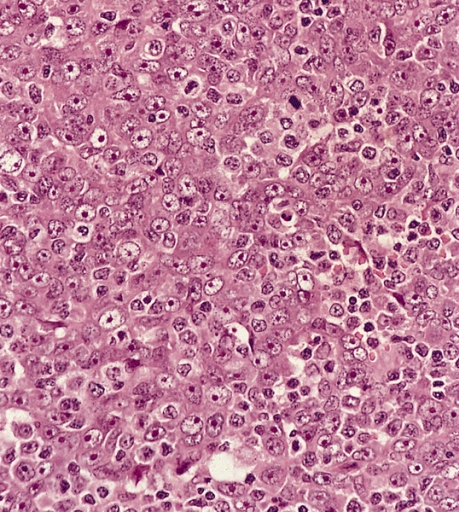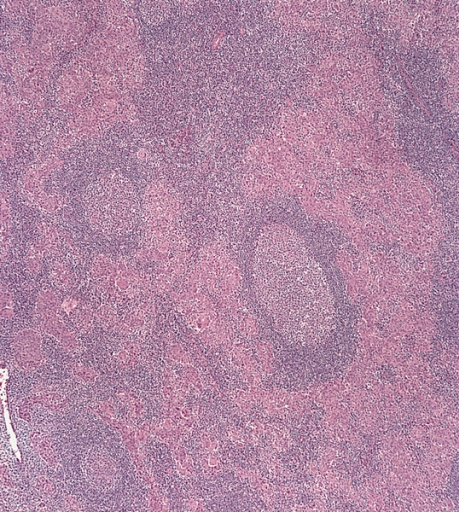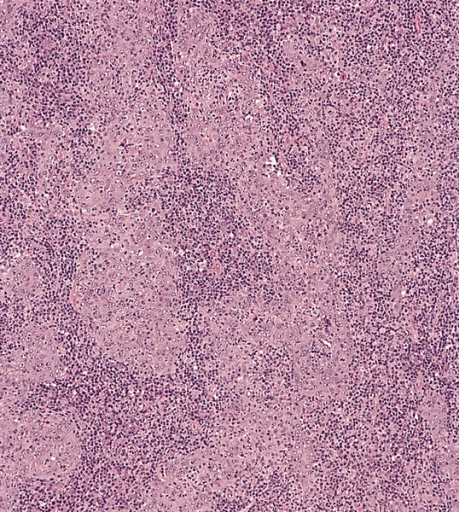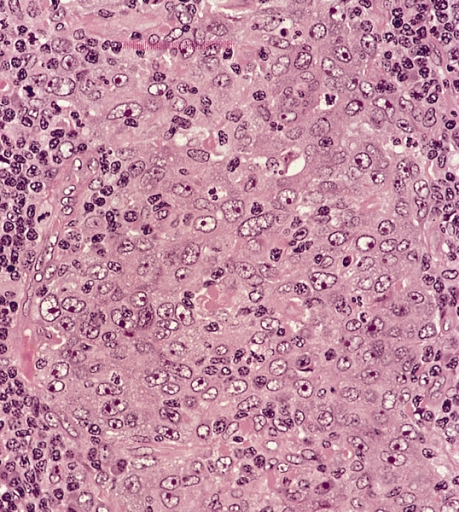Nasopharyngeal carcinoma pathophysiology: Difference between revisions
No edit summary |
m (Bot: Removing from Primary care) |
||
| (21 intermediate revisions by 4 users not shown) | |||
| Line 1: | Line 1: | ||
__NOTOC__ | __NOTOC__ | ||
{{Nasopharyngeal carcinoma}} | {{Nasopharyngeal carcinoma}} | ||
{{CMG}} {{AE}}{{Faizan}} | {{CMG}} {{AE}}{{Homa}}{{Faizan}} | ||
==Overview== | ==Overview== | ||
On [[microscopic]] [[histopathological]] analysis, abundant dense [[eosinophilic]] cytoplasm and prominent [[lymphoid]] component are characteristic findings of [[nasopharyngeal carcinoma]]. | On [[microscopic]] [[histopathological]] analysis, abundant dense [[eosinophilic]] cytoplasm and prominent [[lymphoid]] component are characteristic findings of [[nasopharyngeal carcinoma]]. | ||
==Pathophysiology== | ==Pathophysiology== | ||
==Gross== | ===Genetics=== | ||
*Nasal cavity involvement - common in early disease<ref name=pmid22194474 >{{Cite journal | last1 = Abdel Khalek Abdel Razek | first1 = A. | last2 = King | first2 = A. | title = MRI and CT of nasopharyngeal carcinoma. | journal = AJR Am J Roentgenol | volume = 198 | issue = 1 | pages = 11-8 | month = Jan | year = 2012 | doi = 10.2214/AJR.11.6954 | PMID = 22194474 }}</ref> | [[Gene|Genes]] involved in the [[pathogenesis]] of nasopharyngeal carcinoma include: | ||
==Microscopic== | *''[[MDM2]]'' | ||
Features:<ref name= Librepathology>Nasopharyngeal carcinoma http://librepathology.org/wiki/index.php/Nasopharyngeal_carcinoma</ref> | *''[[TP53]]'' | ||
*Prominent lymphoid component - '''key feature''' | *''[[RAD51L1]]'' | ||
*Features of squamous cell carcinoma: | *''[[TNFRSF19]]'' | ||
**Cohesive cells with: | *''[[CDKN2A]]'' | ||
***Abundant dense eosinophilic cytoplasm | *''[[CDKN2B]]'' | ||
***Central nuclei +/- small/indistinct nucleoli | ==Pathology== | ||
[[Image:Lymphoepithelioma_met_to_LN_6.jpg |thumb|none|250px| Nasopharyngeal carcinoma]] | ===Gross Pathology=== | ||
*[[Nasal cavity]] involvement - common in early [[disease]]<ref name="pmid22194474">{{Cite journal | last1 = Abdel Khalek Abdel Razek | first1 = A. | last2 = King | first2 = A. | title = MRI and CT of nasopharyngeal carcinoma. | journal = AJR Am J Roentgenol | volume = 198 | issue = 1 | pages = 11-8 | month = Jan | year = 2012 | doi = 10.2214/AJR.11.6954 | PMID = 22194474 }}</ref> | |||
{| | The [[tumor]] arises from [[epithelial cells]] on the surface of the nasopharynx. | ||
===Microscopic Pathology=== | |||
Features:<ref name="Librepathology">Nasopharyngeal carcinoma http://librepathology.org/wiki/index.php/Nasopharyngeal_carcinoma</ref> | |||
*Prominent [[lymphoid]] component ([[Lymphoepithelioma]]) - '''key feature''' | |||
*Features of [[squamous cell carcinoma]]: | |||
**Cohesive [[Cells (biology)|cells]] with: | |||
| | ***Abundant [[dense]] [[eosinophilic]] [[cytoplasm]] | ||
| | ***[[Central]] [[nuclei]] +/- small/indistinct [[nucleoli]] | ||
| | |||
| | [[Image:Lymphoepithelioma_met_to_LN_6.jpg |thumb|none|250px| Nasopharyngeal carcinoma]]<br> | ||
| | [[Nasopharyngeal carcinoma]] may be [[Classification|classified]] according to [[microscopic]] [[Features (pattern recognition)|features]] into 3 subtypes:<ref name="Weidner's">{{cite book |author=Richard Cote, Saul Suster, Lawrence Weiss, Noel Weidner (Editor) |title=Modern Surgical Pathology (2 Volume Set) |publisher=W B Saunders |location=London |year= |pages= |isbn=0-7216-7253-1 |oclc= |doi=}}</ref> | ||
| | *Well-[[Differentiation|differentiated]] ([[keratin]]izing type) | ||
*Moderately-[[Differentiation|differentiated]] (nonkeratinizing type) | |||
| | *Undifferentiated (most strongly associated with [[Epstein-Barr virus]] infection) | ||
| | <gallery>Image:Lymphoepithelioma met to LN 4.jpg|Undifferentiated nasopharyngeal carcinoma - low power | ||
Image:Lymphoepithelioma met to LN 1.jpg|Undifferentiated nasopharyngeal carcinoma - med. power | |||
Image:Lymphoepithelioma met to LN 2.jpg|Undifferentiated nasopharyngeal carcinoma - high power | |||
</gallery> | |||
|- | ===Immunohistochemistry=== | ||
| | Immunohistochemistry stains for nasopharyngeal carcinoma include: | ||
*EBER positive | |||
*p16 negative<ref name="pmid9546345">{{cite journal |author=Gulley ML, Nicholls JM, Schneider BG, Amin MB, Ro JY, Geradts J |title=Nasopharyngeal carcinomas frequently lack the p16/MTS1 tumor suppressor protein but consistently express the retinoblastoma gene product |journal=Am. J. Pathol. |volume=152 |issue=4 |pages=865–9 |year=1998 |month=April |pmid=9546345 |pmc=1858242 |doi= |url=}}</ref> | |||
| | |||
==Immunohistochemistry== | |||
*EBER | |||
*p16 | |||
==References== | ==References== | ||
{{Reflist|2}} | {{Reflist|2}} | ||
{{WikiDoc Help Menu}} | {{WikiDoc Help Menu}} | ||
{{WikiDoc Sources}} | {{WikiDoc Sources}} | ||
[[Category: | |||
[[Category: | [[Category:Up-To-Date]] | ||
[[Category:Medicine]] | |||
[[Category:Oncology]] | |||
[[Category:Otolaryngology]] | |||
Latest revision as of 22:54, 29 July 2020
|
Nasopharyngeal carcinoma Microchapters |
|
Differentiating Nasopharyngeal carcinoma from other Diseases |
|---|
|
Diagnosis |
|
Treatment |
|
Case Studies |
|
Nasopharyngeal carcinoma pathophysiology On the Web |
|
American Roentgen Ray Society Images of Nasopharyngeal carcinoma pathophysiology |
|
Risk calculators and risk factors for Nasopharyngeal carcinoma pathophysiology |
Editor-In-Chief: C. Michael Gibson, M.S., M.D. [1] Associate Editor(s)-in-Chief: Homa Najafi, M.D.[2]Faizan Sheraz, M.D. [3]
Overview
On microscopic histopathological analysis, abundant dense eosinophilic cytoplasm and prominent lymphoid component are characteristic findings of nasopharyngeal carcinoma.
Pathophysiology
Genetics
Genes involved in the pathogenesis of nasopharyngeal carcinoma include:
Pathology
Gross Pathology
- Nasal cavity involvement - common in early disease[1]
The tumor arises from epithelial cells on the surface of the nasopharynx.
Microscopic Pathology
Features:[2]
- Prominent lymphoid component (Lymphoepithelioma) - key feature
- Features of squamous cell carcinoma:

Nasopharyngeal carcinoma may be classified according to microscopic features into 3 subtypes:[3]
- Well-differentiated (keratinizing type)
- Moderately-differentiated (nonkeratinizing type)
- Undifferentiated (most strongly associated with Epstein-Barr virus infection)
-
Undifferentiated nasopharyngeal carcinoma - low power
-
Undifferentiated nasopharyngeal carcinoma - med. power
-
Undifferentiated nasopharyngeal carcinoma - high power
Immunohistochemistry
Immunohistochemistry stains for nasopharyngeal carcinoma include:
- EBER positive
- p16 negative[4]
References
- ↑ Abdel Khalek Abdel Razek, A.; King, A. (2012). "MRI and CT of nasopharyngeal carcinoma". AJR Am J Roentgenol. 198 (1): 11–8. doi:10.2214/AJR.11.6954. PMID 22194474. Unknown parameter
|month=ignored (help) - ↑ Nasopharyngeal carcinoma http://librepathology.org/wiki/index.php/Nasopharyngeal_carcinoma
- ↑ Richard Cote, Saul Suster, Lawrence Weiss, Noel Weidner (Editor). Modern Surgical Pathology (2 Volume Set). London: W B Saunders. ISBN 0-7216-7253-1.
- ↑ Gulley ML, Nicholls JM, Schneider BG, Amin MB, Ro JY, Geradts J (1998). "Nasopharyngeal carcinomas frequently lack the p16/MTS1 tumor suppressor protein but consistently express the retinoblastoma gene product". Am. J. Pathol. 152 (4): 865–9. PMC 1858242. PMID 9546345. Unknown parameter
|month=ignored (help)


